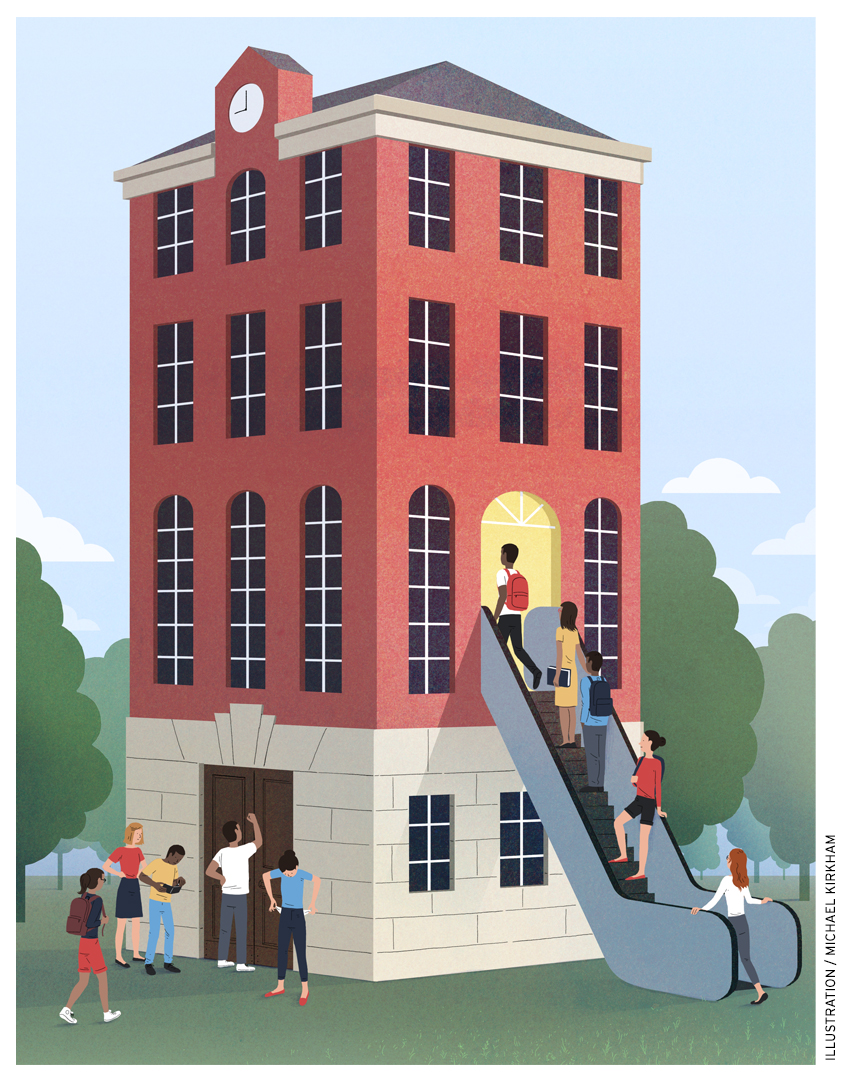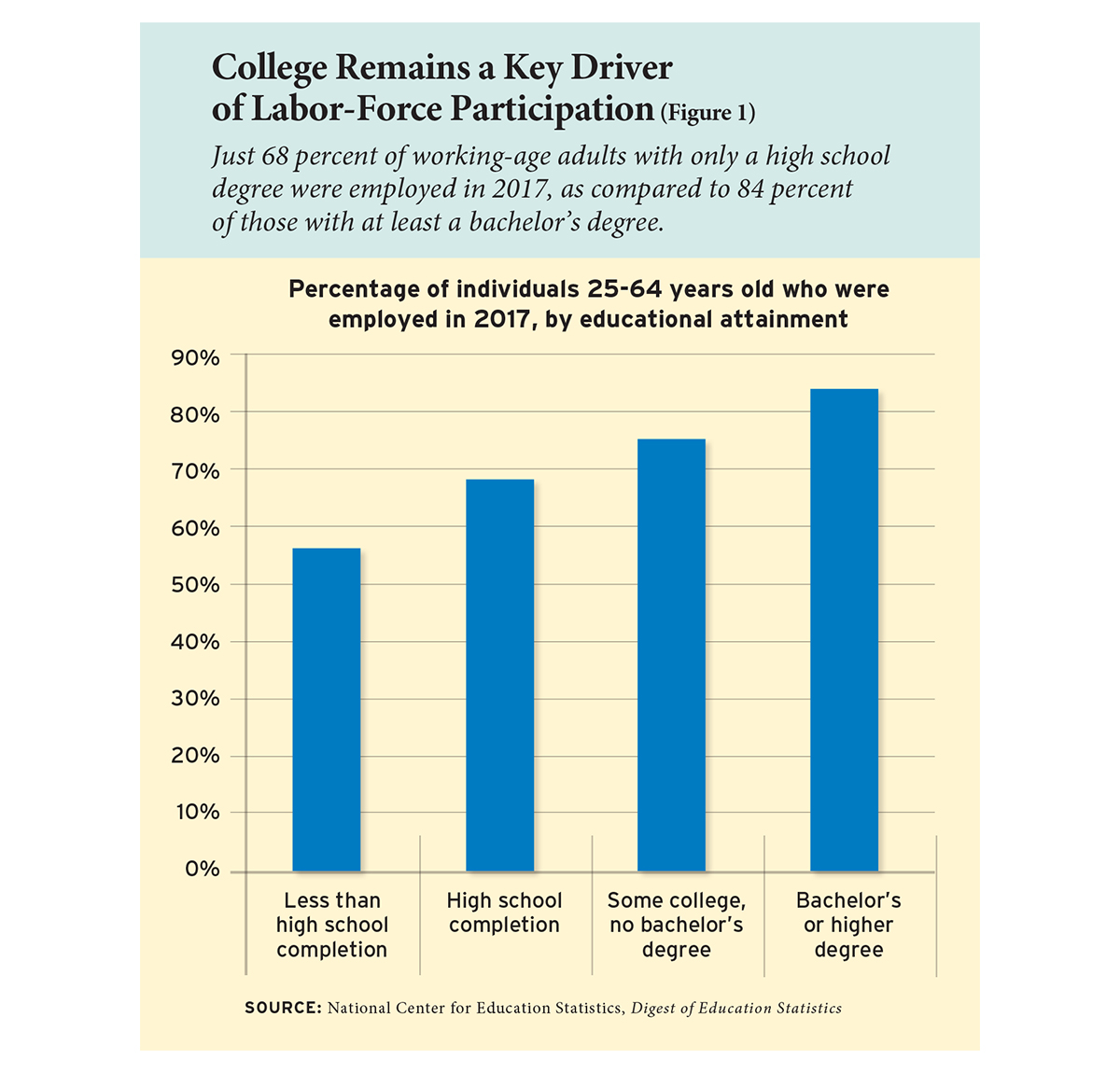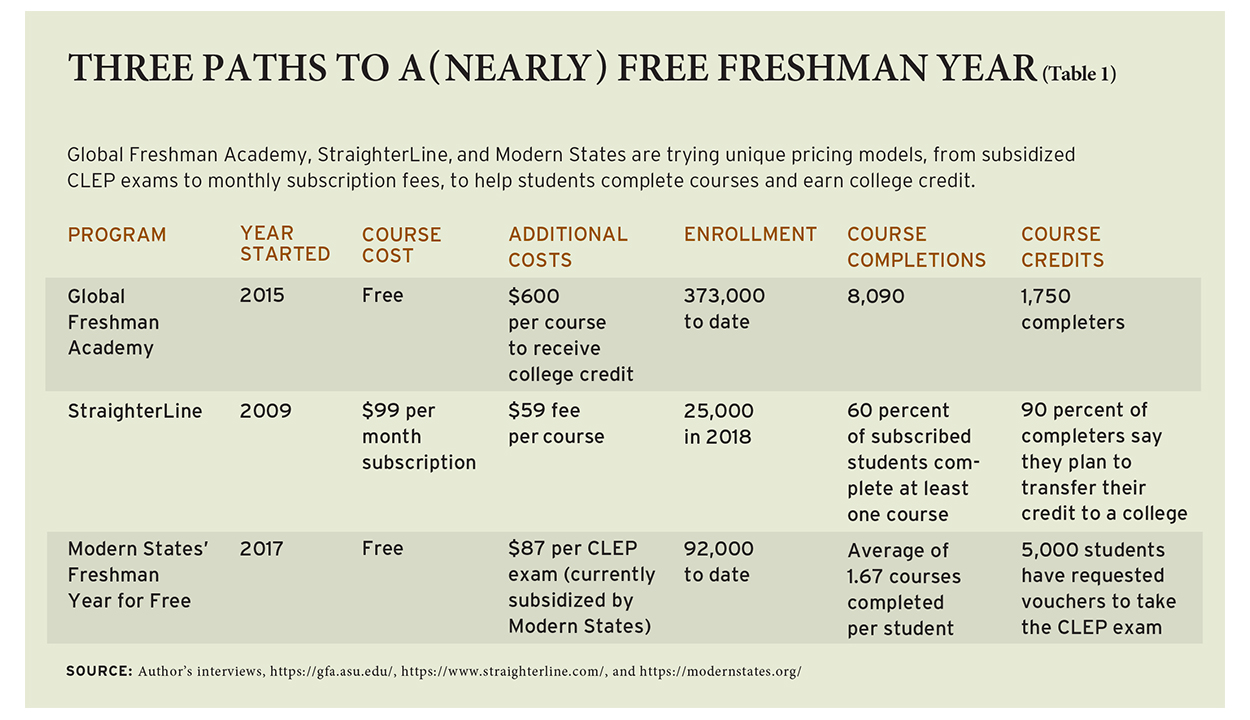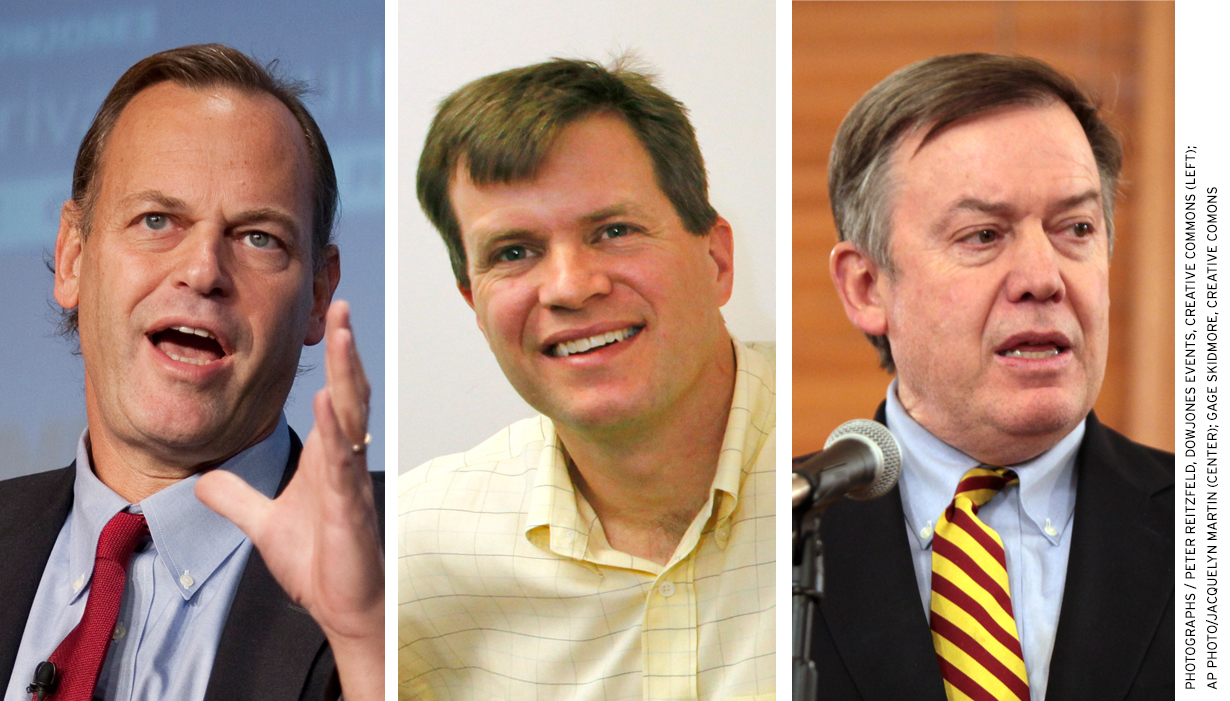 When Arizona State University announced in 2015 that it would offer a freshman year’s worth of credit-bearing “massive open online courses” (MOOCs) for a fraction of the cost of its regular online and in-person classes, the news was met with both excitement and alarm.
When Arizona State University announced in 2015 that it would offer a freshman year’s worth of credit-bearing “massive open online courses” (MOOCs) for a fraction of the cost of its regular online and in-person classes, the news was met with both excitement and alarm.
Education reformers proclaimed the move groundbreaking, saying it would open up higher education to underserved populations at home and around the world. The program’s name reflected that ambition: Global Freshman Academy.
“This is truly revolutionary,” Anant Agarwal, CEO of the nonprofit MOOC provider edX, Arizona State’s partner in the deal, told the Washington Post at the time.
But some academics saw the new model as a threat to traditional colleges, warning that it would steal students from community colleges and regional public institutions and destroy the livelihood of faculty members.
“Education technology has just become weaponized,” wrote Jonathan Rees, a history professor at Colorado State University Pueblo, in a blog post. “Arizona State is now the first predator university.”
Three years on, both the hype and the hysteria seem overblown. Though the program has drawn large numbers of students, it’s been plagued by the same problems that have dogged MOOCs since their creation: low completion rates and a high percentage of learners who already have degrees. Of the 373,000 students who have enrolled, barely 2 percent of students (8,090) have completed a course with a grade of C or better, and under 22 percent of the completers (roughly 1,750 students) have received credit from Arizona State (ASU) for their work. Fewer than 150 have enrolled in the university as regular students.
These low completion rates do not surprise Paul J. LeBlanc, president of Southern New Hampshire University, which serves about 3,000 students on campus and more than 60,000 through its online division.
“Anytime you talk about free, you get large numbers at the top of the funnel, and small numbers at the bottom,” he said. Curious students sign up, and when their interest wanes, they drop out. “There’s no skin in the game.”
But Global Freshman Academy, which gives students the option of paying for academic credit after they successfully complete a course, was supposed to be different from most MOOC providers. The promise of low-cost credit—just $600 a course—was meant to be the carrot that would attract a less-educated student and drive up persistence rates. That hasn’t happened, at least not on the scale reformers predicted.
Though close to half (44 percent) of students who have sought credit have only a high school diploma, nearly a third of them have at least an associate’s degree, and almost a quarter have a bachelor’s degree or higher. While more than 60 percent of learners live abroad, U.S. residents constitute the vast majority of the students who have sought credit.
Philip Regier, dean for educational initiatives at ASU, blames the disappointing numbers on a lack of awareness of the program. “We don’t have hundreds of thousands of marketing dollars to spend on it,” he said. “Many, many people do not yet understand that it’s available to them.”
Although Global Freshman Academy and other programs that seek to unbundle freshman year, such as StraighterLine and Freshman Year for Free, have yet to become household names, the need for cheaper, more flexible pathways to a college credential is clear. A growing number of jobs today require postsecondary education: in 2017, 68 percent of individuals holding only a high-school diploma were employed, in contrast to 84 percent of those with at least a bachelor’s degree (see Figure 1). Yet more than half of Americans over the age of 25 lack even an associate’s degree, and in many underdeveloped countries, attainment rates are even lower. Often, adult learners don’t have the time or resources to enroll in a mainstream four-year college, or even a marginally cheaper online program.

Meanwhile, the cost of college continues to climb, and with it, student debt. Nationally, two out of every three seniors who graduated from public and nonprofit colleges in 2017 carried student debt averaging $28,650, according to the Institute for College Access and Success. These rising costs and debt burdens are making it harder for low-income and debt-averse young people to afford a degree, contributing to a growing skills gap.
To continue to serve as an engine of opportunity, the American higher-education industry will need to create more low-cost pathways that appeal to adult learners and low-income, first-generation students alike. But Global Freshman Academy and other innovative Web-based programs face obstacles to growth beyond the lack of public awareness.
Take cost. Unlike traditional colleges, these programs aren’t accredited, and therefore aren’t eligible to award federal student aid. That means that low-income students must pay out-of-pocket. While the programs cost far less than a four-year public institution, even a couple hundred dollars can put college out of reach for a poor student.
Programs such as Global Freshman Academy also provide fewer student supports than traditional campuses—supports that, studies show, bolster the likelihood of success for low-income and first-generation students. Adding more counselors and advisors would likely improve completion rates, but it would also force the programs to raise their tuition, pricing out more students.
To be truly transformative—and sustainable—Global Freshman Academy and its peers will have to tackle these daunting challenges.
Still, some signs indicate that such programs are already having an impact on the higher-ed landscape. By proving the feasibility of offering high-quality, low-cost, entry-level courses for credit, ASU is putting pressure on other institutions to follow suit.
And by treating the open courses the same as in-person ones on its transcripts, the university is enhancing the credibility of MOOC-based programs (or devaluing the traditional academic credit, depending on whom you ask).
Origins
Global Freshman Academy wasn’t the first to try to radically reduce the cost and risk of attending college online.
For nearly a decade, the for-profit company StraighterLine has offered a $99-a-month all-you-can-learn subscription and guaranteed credit at 130 partner colleges. The company also charges a fee of $59 per course, but all told, a student enrolled for nine months can get a year’s worth of credits for under $1,500, less than a third of what eight courses at Global Freshman Academy would cost.
Last year, StraighterLine enrolled more than 25,000 students in general-ed courses. More than 60 percent of its students complete a course, and most of them—90 percent—say they plan to transfer their credit to a college.
Like Global Freshman Academy, StraighterLine generated a lot of buzz when it launched in 2009, three years before the MOOC craze began. Fast Company named it one of the “10 most innovative companies in education,” and reformers hailed the company’s founder, Burck Smith, as a revolutionary.
But StraighterLine, like Global Freshman Academy, met with skepticism from academe. Early on, a handful of mainstream colleges that had agreed to award credit for StraighterLine courses backed out, leaving mostly for-profits and adult-serving institutions as partners. The dropouts said the agreement wasn’t boosting their enrollment and was cutting into revenue from their own online offerings.
Looking back, Smith attributes the initial attrition to a bias against for-profit education, and a “knee-jerk reaction” that an online, low-cost education “must be low quality.”
Back in 2009, it was “politically fraught” for colleges to fraternize with for-profit companies, Smith said. These days, the association doesn’t carry the same stigma.
“The national conversation has changed,” he said.
Today, the partner colleges provide a major pipeline, sending students to StraighterLine to knock out some prerequisites or prove themselves ready to enroll (or re-enroll) in college, Smith said. They’ll also refer students who are at risk of dropping out because they’ve exhausted their eligibility for federal aid or face scheduling challenges.
Smith has had less luck selling students on a full freshman year’s worth of courses. The company dropped its discounted “first-year bundle” a couple of years ago, after hardly anyone purchased the package. On average, students complete four courses, less than half of what the bundle covered.
Smith argues that even if there isn’t demand for a freshman-year package, there’s still a benefit to unbundling general education. In September, a running tally on the company’s website estimated that the courses have saved students and taxpayers close to $160 million in tuition and fees over the costs of comparable courses at a four-year public institution.
Smith won’t disclose how much money the company is making, but said he’s “fairly happy” with progress to date. The biggest constraint to future growth, as he sees it, is the company’s lack of access to federal financial aid.
“We are cheap, but we can’t compete with free,” he said.
The U.S. Department of Education (ED) is currently testing the idea of opening up federal coffers to online education programs such as Smith’s, but the experiment has gotten a slow start. Three years in, ED has approved only one partnership—between StraighterLine and Dallas County Community College District—and it is more traditional than StraighterLine’s regular offering. Classes are tied to the academic calendar, and students pay a flat fee of $174 per credit, rather than $99 per month. There’s no free trial.
Smith worries those differences could make the hybrid program less appealing—and ultimately less disruptive—than StraighterLine’s subscription model.
Still, he sees the pilot as a way to start chipping away at the federal ban on aid to so-called “non-institutional providers” and to “create some space for innovation” within the confines of current law.

Freshman Year for Free
But getting Congress to embrace new ways of educating people isn’t easy, as Steven B. Klinsky, the founder and CEO of the nonprofit Modern States, knows all too well. (Note: Klinsky chairs the advisory committee to the Program on Education Policy and Governance at Harvard University, within which Education Next is housed.)
In 2012, at the height of the MOOC craze, Klinsky, a venture capitalist and philanthropist, decided the nation needed a new, innovation-focused accreditor that would recognize specific courses for credit. So he joined forces with a former ED official, David A. Bergeron, then at the Center for American Progress, and set about creating one.
The pair wrote articles promoting the plan, and walked the halls of the department and Congress, trying to get the government to recognize their new accreditor. They failed.
“Rather than keep knocking our heads against the wall, politically,” said Klinsky, he and Bergeron started looking for more practical ways to accomplish their goal of providing free courses for credit. Their solution: a set of courses, created by top faculty at prestigious colleges, that would prepare students to take the College Board’s Advanced Placement and College Level Examination Program (CLEP) exams. (The CLEP assesses college-level knowledge in 33 subject areas, with passing scores accepted for credit at more than 2,900 institutions.)
They called the new program Freshman Year for Free, and said it could reduce the cost of a traditional four-year degree by 25 percent. Klinsky even offered to cover the fees for the first 10,000 exams.
In its first year, more than 80,000 people signed up for the courses, and a little over 5,000 requested vouchers to take a CLEP exam (none took AP exams). The actual number of test-takers may be higher, since the military pays exam fees for its members, and some learners may have paid out-of-pocket.
The completers include home-schoolers like Sarah Schneider, who took time off after finishing high school and wanted to catch up with her peers. She took seven Modern States classes while attending Baton Rouge Community College, and passed every CLEP exam, shaving a year off her college career and saving herself thousands in tuition.
Schneider, who transferred to Louisiana State University last fall, said that when she saw the ad for Modern States, she thought it must be a scam. No one would give away college credit for free. But she was paying her own way through college, and decided to give it a shot. To her surprise, the courses were at least as good—or better—than her community college ones, she said.
“I would highly recommend it to anyone trying to get through school quickly or cheaply,” she said.
The average number of courses that students complete is 1.67, and so far, 38 students have taken enough to get a full freshman year for free. But it’s early still, and Klinsky, who has spent a “few million” on the project, argues that the charity has already justified its cost, saving students an estimated $5 to $10 million, based on a typical cost of $1,000 to $2,000 per online course.
Klinsky says he isn’t bothered by the fact that only 6 percent of learners have sought exam vouchers. As he sees it, Modern States is like a free public library, where learners can choose to browse or study a topic deeply.
“If you want to learn the material and not go for credit, that’s not a failure: you’re learning what you want to learn,” he said. “No one is wasting money on an uncompleted course, because they’re not paying money.”
Those who do succeed on the tests stand to benefit in other ways. Passing even a single CLEP exam, as compared with taking the exam but failing to receive credit, leads to a 17 percent (5.7-percentage-point) increase in associate’s degree completion for students attending community colleges, according to a recent study.
As Modern States enters its second year, Klinsky is trying to build state and philanthropic support for his idea. In June, he and former Florida governor Jeb Bush penned an opinion piece that urged governors to cover the costs of the exams, arguing that it would be the most cost-effective way for them to raise state attainment rates. Klinsky is also seeking donors to subsidize the exams going forward. CLEP exams cost $87 each; AP exams cost $94.
If no one volunteers, Klinsky said he will likely continue to cover the fees, adding that even if he doesn’t, $87 for three or more college credits would still be a bargain.
Kick-Starting College
Morgan Carver Richards, 33, was an expat living in Dubai and rearing three young children when she discovered Global Freshman Academy through a search for online programs. Her husband, a pilot for Emirates airline, had attended Arizona State, so she trusted the brand, she said.
But what really sold her on the program were its low price and its convenience. She could study from home while her kids slept or played, and her credits would transfer just as if she’d taken the classes in person.
She enrolled, took 12 credits, and then transferred into the online program when her family moved back to the States two years ago. When her youngest started kindergarten last fall, she finally started taking classes in person, at the main campus. She’s on track to graduate with a bachelor’s degree in anthropology this spring or summer, and hopes to earn a PhD from Arizona State afterward.
“I was able to kick-start my life,” she said.
Global Freshman Academy, at $200 per credit hour, costs significantly less than ASU Online, which charges undergraduates $520 to $728. It’s a steal compared to Arizona State (in Tempe), where out-of-state undergraduates pay nearly $30,000 in tuition and fees.
But it’s still expensive compared to community college, where annual in-district tuition and fees averaged $3,660 in 2018, according to the College Board. And students attending community colleges qualify for federal student aid, while students in Global Freshman Academy do not.
The out-of-pocket costs could be one reason a majority of completers aren’t pursuing credit for their work. It’s also possible that some students never intend to seek credit, and enroll only for their own edification.
But why are so many failing to complete the courses to begin with? That’s a tougher question to answer, experts say.
One theory is that students aren’t finishing because they have nothing at stake. Like MOOCs, Global Freshman Academy charges nothing upfront, so students lose nothing if they drop their courses. The only learners with “skin in the game” are those who have paid a $45 fee to take proctored exams and be considered for credit.
Or maybe students are dropping out because they aren’t getting the support they need to succeed. Studies consistently show that low-income and first-generation students—the target population of Global Freshman Academy—do better in face-to-face and hybrid classes than online-only ones.
Global Freshman Academy does offer some supports, including a technical help team and teaching assistants who can answer content-related questions. The program also provides students with personalized feedback on what they’ve learned and how much they’ve retained.
But at-risk undergraduates often need more than just technical or academic assistance; they also need emotional support and encouragement, said Phil Hill, co-publisher of the e-Literate blog.
Richards, who had taken only a couple of community-college courses before enrolling in Global Freshman Academy, said she adjusted easily to the technology behind the program. The only technical challenge occurred during one final exam, when her answers weren’t recorded and she couldn’t get credit for the course.
Still, she says she prefers learning in person, where she can interact one-on-one with her professors and peers.
“I benefit from being able to ask questions during lectures, and to sit down and have a face-to-face conversation if I’m struggling,” she said.

Grad School Online
The difference between undergraduate and graduate students may explain why students have performed better in MOOC-inspired master’s programs, such as Georgia Institute of Technology’s online master’s in computer science, than in Global Freshman Academy. Graduate students tend to be more mature, independent learners who “know what they want” and have the self-discipline and study skills to succeed online, Hill said.
Georgia Tech’s program, which was developed with another MOOC platform, Udacity, costs about a sixth of the price of an in-person degree, and has a retention rate of 60 percent. This year, 1 out of every 12 of the nation’s graduates with a master’s in computer science will come from the Georgia Tech online program.
Moreover, the program seems to be serving an older, domestic population of students who would not otherwise get master’s degrees, according to a recent analysis by researchers at Harvard University and Georgia Tech (see “An Elite Grad-School Program Goes Online,” research, Summer 2018).
Agarwal of edX views the recent embrace of “MicroMasters” programs as evidence that the MOOCs-for-credit concept is catching on in change-resistant academe. Such programs consist of online graduate-level courses that lead to a certificate in a professional career area, such as health-care administration, business fundamentals, and design thinking. More than 30 institutions, including prestigious ones such as Columbia University, have joined an edX consortium offering the credentials. All the edX MicroMasters allow students to apply the course credits toward a full master’s program.
Comparing Global Freshman Academy to these programs may not be entirely fair: after all, the Georgia Tech and MicroMasters students have invested money up front; Global Freshman Academy’s have not. Still, the success of Georgia Tech’s program raises questions about whether the model can have the same impact with a more at-risk, undergraduate population.
“There’s a bit of danger in the tech world of thinking if you just find the right technology, you will solve problems that are a lot deeper than technological problems,” said Joshua Goodman, an associate professor of public policy at Harvard and one of the researchers who studied Georgia Tech’s program. “The technology may remove some barriers, but not all.”
Zvi Galil, dean of Georgia Tech’s College of Computing, said undergraduates who study solely online miss out on the maturing, socializing, and networking that take place on campus. Still, he believes that delivering some freshmen-level courses online could shorten the time students spend in the classroom—and lower their costs. His university is experimenting with that approach now, with a few introductory computer-science courses. For now, the institution offers no tuition cut for students who choose the online option, but Galil hopes it will in the future.
Galil sees Arizona State’s efforts to dramatically lower the cost of freshman year as “in the same spirit as what we do.”
“Michael Crow is a visionary,” he said of ASU’s president.
Looking Forward
But is Crow’s vision sustainable? It costs Arizona State at least $100,000 to build each course offered through Global Freshman Academy. The university has developed 14 so far and plans to create a total of at least 25. To recoup that initial $2.5 million, the college would need to have 4,166 completers pay for credit.
Regier, a former accounting professor, said he’s confident that the program will prove a good investment for the university as more students discover it. He points out that the cost of running the program, once the courses are developed, is pretty low.
In an effort to grow its user base, the university is reaching out to school districts in major cities, including Chicago and Los Angeles. “We’re still in a maturation phase,” Regier said.
Still, experts say that if Global Freshman Academy is going to live up to its potential to democratize higher education, it will need to do more than just broaden the funnel; it will need to take a hard look at which students are succeeding, what it must do to recruit more of them, and how it can get more would-be dropouts to persist.
The question, said Louis Soares, chief learning and innovation officer at the American Council on Education, is, “Can you improve the results, and is there a plan to do so?”
Meanwhile, critics of the program continue to see it as a menace—if a slightly less scary one.
“It may not be a particularly effective weapon,” said Rees, the CSU Pueblo professor. “But at the same time, a lot of people may be wounded by it. . . . I worry about an all-MOOC education, making both better online and face-to-face programs no longer economically viable.”
But Jeffrey J. Selingo, who has written books on disruption in higher education, said programs like Global Freshman Academy will never displace traditional colleges and universities.
“The markets out there are huge, not only in the U.S., but around the world. You’re not going to be able to squeeze every high-school graduate through the same pathway that everyone traditionally followed,” Selingo said.
“To me, it’s not a threat; it’s an expansion.”
Kelly Field is a freelance journalist based in Boston who covers higher education.
This article appeared in the Spring 2019 issue of Education Next. Suggested citation format:
Field, K. (2019). Entrée to Freshman Year: Online programs offer low-cost courses for college credit. Education Next, 19(2), 48-54.


